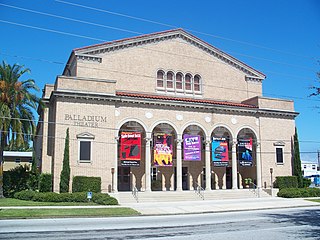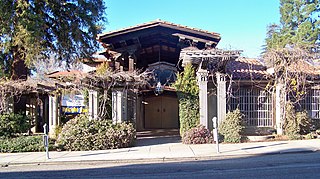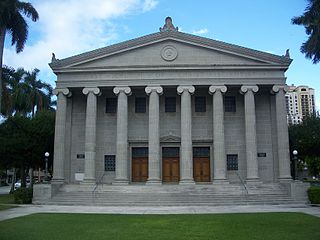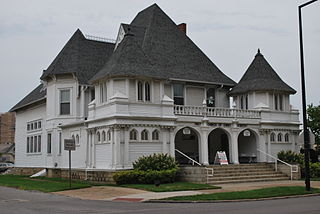First Church of Christ, Scientist | |
First Church of Christ Scientist, now the Palladium at St. Petersburg College, in 2008 | |
| Location | 253 Fifth Ave. North, St. Petersburg, Florida |
|---|---|
| Part of | North Shore Historic District (#03000040) |
| Added to NRHP | February 20, 2003 |
The Palladium at St. Petersburg College, formerly the First Church of Christ, Scientist, is an historic Christian Science church building located at 253 Fifth Avenue North, in the Old Northeast (St. Petersburg, Florida) neighborhood of St. Petersburg, Florida. Built in 1925, it was designed as a basilican structure in the Romanesque Revival style of architecture by architect Howard Lovewell Cheney. Cheney used Filippo Brunelleschi's 15th century Ospedale degli Innocenti in Florence as his inspiration. The builder was the George A. Fuller Construction Company of New York City, then one of the nation's leading builders.

Christian Science is a set of beliefs and practices belonging to the metaphysical family of new religious movements. It was developed in 19th-century New England by Mary Baker Eddy, who argued in her 1875 book Science and Health that sickness is an illusion that can be corrected by prayer alone. The book became Christian Science's central text, along with the Bible, and by 2001 had sold over nine million copies.

St. Petersburg is a city in Pinellas County, Florida, United States. As of the 2015 census estimate, the population was 257,083, making it the fifth-most populous city in Florida and the largest in the state that is not a county seat.

Romanesque Revival is a style of building employed beginning in the mid-19th century inspired by the 11th- and 12th-century Romanesque architecture. Unlike the historic Romanesque style, however, Romanesque Revival buildings tended to feature more simplified arches and windows than their historic counterparts.
The building was sold in 1998 to the Palladium Theater, which renovated it for its own use, while preserving as much as possible of the interior, including the 1926 Skinner organ and the magnificent Arts and Crafts style art titlework which came from the Los Angeles studios of famed tilemaker Ernest A. Batchelder. In 2007, the Palladium Theater was given to St. Petersburg College and it is now called the Palladium at St. Petersburg College. [1] [2]

Æolian-Skinner Organ Company, Inc. of Boston, Massachusetts was an American builder of a large number of pipe organs from its inception as the Skinner Organ Company in 1901 until its closure in 1972. Key figures were Ernest M. Skinner (1866–1960), Arthur Hudson Marks (1875–1939), Joseph Silver Whiteford (1921-1978), and G. Donald Harrison (1889–1956). The company was formed from the merger of the Skinner Organ Company and the pipe organ division of the Æolian Company in 1932.

A tile is a thin object usually square or rectangular in shape. Tile is a manufactured piece of hard-wearing material such as ceramic, stone, metal, baked clay, or even glass, generally used for covering roofs, floors, walls, or other objects such as tabletops. Alternatively, tile can sometimes refer to similar units made from lightweight materials such as perlite, wood, and mineral wool, typically used for wall and ceiling applications. In another sense, a tile is a construction tile or similar object, such as rectangular counters used in playing games. The word is derived from the French word tuile, which is, in turn, from the Latin word tegula, meaning a roof tile composed of fired clay.
Ernest Allan Batchelder was an American artist and educator who made Southern California his home in the early 20th century. He created art tiles and was a leader in the American Arts and Crafts Movement.
The building is a contributing property in the North Shore Historic District which was added to the National Register of Historic Places on February 20, 2003. [3]

In the law regulating historic districts in the United States, a contributing property or contributing resource is any building, object, or structure which adds to the historical integrity or architectural qualities that make the historic district, listed locally or federally, significant. Government agencies, at the state, national, and local level in the United States, have differing definitions of what constitutes a contributing property but there are common characteristics. Local laws often regulate the changes that can be made to contributing structures within designated historic districts. The first local ordinances dealing with the alteration of buildings within historic districts was in Charleston, South Carolina in 1931.

The North Shore Historic District, commonly known as Old Northeast or Historic Old Northeast, is a U.S. historic district located in St. Petersburg, Florida. The district, located adjacent to Downtown, is bounded by 4th Street N, 5th Avenue N, Tampa Bay, and 30th Ave N. It contains 2975 historic buildings and 4 objects. Ths area is mostly residential but does contain some retail, dining, parks and city landmarks. It also has been featured in the "Great Homes and Destinations" section of the New York Times.

The National Register of Historic Places (NRHP) is the United States federal government's official list of districts, sites, buildings, structures, and objects deemed worthy of preservation for their historical significance. A property listed in the National Register, or located within a National Register Historic District, may qualify for tax incentives derived from the total value of expenses incurred preserving the property.
First Church of Christ, Scientist, now holds services at 6333 First Street, Northeast in St. Petersburg. [4]


















